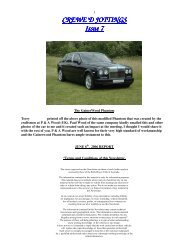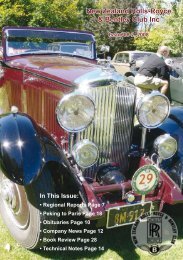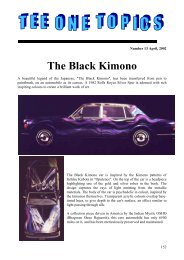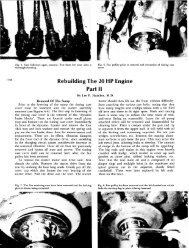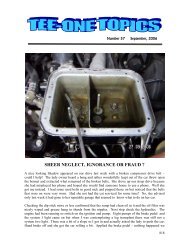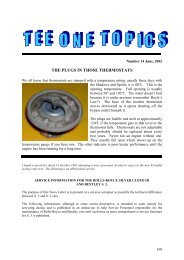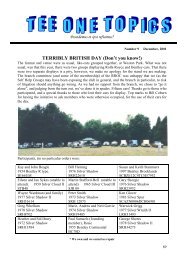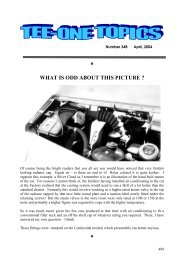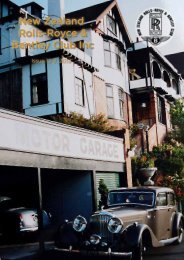New Zealand Rolls-Royce & Bentley Club Inc - The Enthusiasts ...
New Zealand Rolls-Royce & Bentley Club Inc - The Enthusiasts ...
New Zealand Rolls-Royce & Bentley Club Inc - The Enthusiasts ...
Create successful ePaper yourself
Turn your PDF publications into a flip-book with our unique Google optimized e-Paper software.
This year the “Derby” <strong>Bentley</strong> is 75 years old. In a life span of<br />
only six trading seasons, cut short by the Second World War,<br />
the car achieved the status of a bench mark against which all its<br />
contemporaries can be measured and found wanting.<br />
<strong>Rolls</strong>-<strong>Royce</strong> Limited bought <strong>Bentley</strong> Motors through<br />
a nominee company on 13 November 1931 for £125,000 and<br />
immediately formed <strong>Bentley</strong> Motors (1931) Ltd. Napier had<br />
been on the verge of buying the company which W.O. <strong>Bentley</strong><br />
had founded but over which he had lost control, and <strong>Rolls</strong>-<strong>Royce</strong>,<br />
since they had achieved ascendancy over Napier’s aircraft engines<br />
with their “R” racing engine, had no wish to engage in competition<br />
with Napier on the road in a new Napier-<strong>Bentley</strong> design, likely to<br />
be a descendent of the highly regarded 8-litre <strong>Bentley</strong>. <strong>The</strong> existing<br />
<strong>Rolls</strong>-<strong>Royce</strong> Phantom II was a very large car, and hardly suited for<br />
the owner-driver, while the 20/25 had continued to gain weight.<br />
To plug a perceived gap in the market, <strong>Royce</strong> initiated the design<br />
of a new 2½ litre engine and chassis, to be called the Peregrine.<br />
By the end of 1931, the design team, led by Sir Henry<br />
<strong>Royce</strong>, at West Wittering in Sussex, were at work on just what<br />
the “new” <strong>Bentley</strong> would be, and E.W. (later Lord) Hives (Hs),<br />
R.W. Harvey-Bailey (By) and W.A. Robotham (Rm) had the<br />
task of developing the new “Bensport.” This work took most of<br />
1932, with various engine chassis, and transmission variations<br />
considered. <strong>The</strong> Peregrine chassis was accepted as the basis for<br />
the new “Bensport”, but to provide the “edge” thought necessary<br />
in a <strong>Bentley</strong> design, overhead camshaft and supercharger options<br />
were tried and rejected respectively as lacking in refinement, and<br />
providing complications of lubrication as well as detonation and<br />
gasket problems. To compete supercharged in the 3-litre class the<br />
Peregrine engine would have had to have been made still smaller,<br />
and <strong>Royce</strong> also suggested a straight-eight 3-litre design around the<br />
Peregrine 2.725½” by 4.125½” dimensions.<br />
<strong>The</strong> happy merging of a 20/25 development engine and<br />
gearbox (this “J1” engine had a six inlet port cylinder head, a<br />
modified camshaft, 6.4:1 compression and twin S.U. carburettors<br />
on a new inlet manifold and had been under test in a 20/25 <strong>Rolls</strong>-<br />
<strong>Royce</strong>) meant that a mock-up was ready for the road in January<br />
1933, clad in a Park Ward saloon body. Either this first car, 1-B-III<br />
(according to Alec Harvey-Bailey), or 1-B-IV (according to Ian<br />
Rimmer) weighed 30.75 cwt and reached 95 m.p.h. while being<br />
taken down to West Wittering by Hs and Rm to show to the dying<br />
Sir Henry <strong>Royce</strong>.<br />
Shortly after this, Hs wrote to A. Wormald (Wor) and A.<br />
F. Sidgreaves (Sg) that the new <strong>Bentley</strong> could not be regarded as a<br />
cheaper <strong>Rolls</strong>-<strong>Royce</strong> option, its technical specification warranting<br />
a margin over the 20/25. He said, “We must make this car as<br />
good as we know how and charge accordingly.” <strong>The</strong> Peregrine<br />
development programme was cancelled, and the new 3 ½ litre<br />
<strong>Bentley</strong> was sufficiently different from all other <strong>Rolls</strong>-<strong>Royce</strong><br />
products to not erode their market. W.O. <strong>Bentley</strong> (Bn) worked<br />
for the Company on 2-B-IV’s testing programme in the Alps, and<br />
spoke glowingly of the new car bearing his name, saying, “<strong>The</strong><br />
way it climbed the various passes was a revelation and I have<br />
never been in a car which made these roads seem so ordinary.”<br />
Four prototypes were built, and they ran up a considerable<br />
mileage each, at least one surviving to develop the “M” series<br />
of overdrive cars, another to have Citroen independent front<br />
suspension fitted, and all to show the results of the Company<br />
policy of arduous testing which included many accidents and<br />
mechanical failures. Front end shake or shimmy was a problem,<br />
and a jig was set up to measure this on 1-B-IV. A solution was seen<br />
in the installation of a Wilmot Breeden harmonic stabiliser bumper<br />
<strong>The</strong> Derby <strong>Bentley</strong> Turns 75 Years Old<br />
17<br />
<strong>The</strong> high standard of finish, with plated tools, is evident on this Van den<br />
Plas drop-head coupé B195JY.<br />
with a lowered front chassis cross member. This bumper was fitted<br />
to 4-B-IV, which had been re-bodied as a Park Ward saloon with<br />
a special engine of 6.9:1 compression and larger inlet valves, but<br />
during road testing by Willoughby Lappin (Lp) with passengers<br />
including Jack Barclay aboard, a mounting bolt broke and one end<br />
of the front bumper dropped and was run over by a front wheel.<br />
<strong>The</strong> overload on the front axle caused it to fail outboard of the<br />
spring, and the car went end over end. Somehow the occupants<br />
were not seriously injured, but to ensure that the accident would<br />
never recur, By designed neat hooked arms extending from the<br />
chassis to fit loosely around the horizontally mounted bumper<br />
spring. Interestingly, Ray Drury’s early Thrupp & Maberly saloon<br />
B24AH, delivered in April 1934, and illustrated on page 18 of 08-<br />
5, does not have these hooks fitted. Did this car slip through the<br />
retro-fitting process, or did it lose the hooks later in its life?<br />
So, what did this new <strong>Bentley</strong> look like? A radiator<br />
very similar to the final “W.O.” 8-litre and 4-litre designs, with<br />
calorstat-operated shutters, sat right over the front axle in the<br />
classic position for aesthetic pleasure and favourable weight<br />
distribution. Flared front mudguards, seen here on B15AE, added<br />
to the lithe appearance of the early Derby <strong>Bentley</strong>s, although<br />
testing soon demonstrated that domed wings, eventually faired in<br />
to front bumper level, produced a favourable increase in top speed,<br />
and the flared mudguards were soon discontinued. Headlamps of<br />
various types were tried, but the Lucas R (or B) 100 became the<br />
standard lamp used. <strong>The</strong>se, and other high quality products such as<br />
Grebel and Marchal lamps, certainly look handsome, but the barn<br />
door effect certainly was a factor, and the September 2008 issue<br />
of <strong>The</strong> Automobile mentions wind tunnel tests which showed that<br />
a streamlined Derby <strong>Bentley</strong> would have been 15 m.p.h. faster in<br />
reverse.



